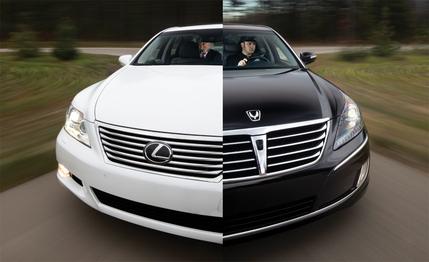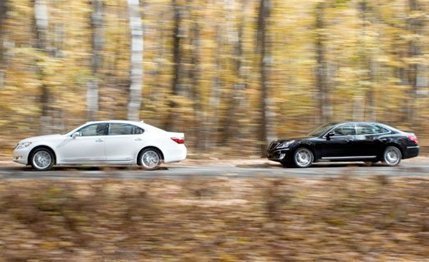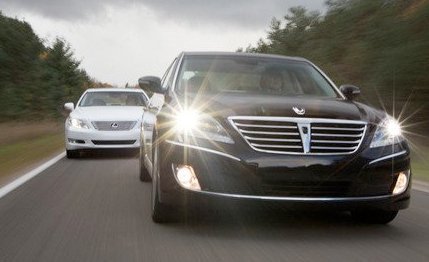 Comparison Tests
Comparison Tests
By the summer of ’89, Americans had come to adore shopping for Toyotas. Almost no thought was required. Toyota had become the go-to supplier for a stem-to-gudgeon lineup of rational, oft-emotionless automobiles. “Uh, yeah, only got 10 minutes, so gimme 10 grand worth of car—blue or green’s okay.” Announcing its 1990 lineup, Toyota was giddy to inform, “The Cressida is offered in several new colors!”
And so the news of a Toyota luxury brand—Lexus—was a bombshell viewed by not a few dealers and journalists as an uppity, above-your-station strategy likely to tank in a tsunami of Japanese apologies and executive firings. “Jeez,” we warned, “sounds risky.”
Little did we know how risky. The 1990 Lexus LS400 represented much that Toyota wasn’t. For starters, it was an object of discretionary income commanding $35,000—$61,732 in today’s cash. Moreover, the car was seemingly twice the size it needed to be, was twice as luxurious as any Toyota before, and was propelled by twice as many cylinders as the Corolla-grade thrusters that had made chairman Eiji Toyoda an internationally revered, well, Yoda.
That wasn’t even the scariest part. We didn’t know it at first, but the Japanese weren’t relying on the LS400 just to fake a heritage and infiltrate an established luxury niche, a niche then defined by BMW, Audi, and Mercedes. Instead, Toyota was also eyeing an amorphous, oft-maligned market that was, all through the ’80s, badly serving its uniquely American customers. What if the LS400 were the world’s most desirable Cadillac Brougham, the most intergalactically fantastic Lincoln Town Car? What if the LS400 were dead reliable and unpretentious, a marriage of filtered ride, silken mechanicals, placid dynamics, and sub rosa luxury? Ready or not, that’s the car Toyota built.

Few luxury offerings have more squarely hit the marketing nail on the head. At the end of its second year, Lexus was already America’s bestselling luxury-import brand. The LS worked so well that, over the course of the next two decades, it never strayed from its original assignment. In 1989, it wasn’t hip to say “I drive a Lincoln,” but it almost overnight became hip to say “I drive a Lexus.” In short, the LS400 made the Lexus brand, which, by 2009, commanded 17.8 percent of the U.S. luxury market.
Enter Hyundai. Well, not exactly. We too often label Hyundai a juvenile upstart, when, in fact, the company set up shop here a quarter-century ago [see timeline]. Even as Lexus trotted out the LS400, Hyundai was launching its first Sonata, and we smirked at the Koreans’ too-big-for-their-britches assertion that the Sonata would one day rival Camrys and Accords.
And, now, history repeats itself. Here comes Hyundai, the paradigm of all things automotively economical, pursuing its own slice of the luxosedan pie. Buoyed by the success of the Genesis and deploying that sedan’s able platform, Hyundai has fashioned an LS460 clone intended to woo annually a mere 2000 to 3000 Americans who found the original LS recipe so enticing. Say hello to the Equus. Say goodbye to all your Mr. Ed jokes.
If it worked for Lexus, it’ll work for Hyundai, right? Not necessarily. For one thing, Hyundai is clinging to its name, warts and all, in hopes that the costly creation of a separate luxury brand won’t be necessary. It thus finds itself hawking a Zegna suit with a made-in-Korea label. Notice that the Hyundai name appears nowhere on the Equus. Maybe that obfuscation will work, although history suggests that manufacturers who spend multiple decades churning out econocars are inextricably wed to econocars. Think Subaru SVX, here. Think Volkswagen Phaeton.

If this über-Hyundai isn’t a hit, however, it won’t be for lack of sedulous benchmarking. When Korean engineers set about copying the modern LS, they swallowed their inventiveness and simply deployed a really good Xerox machine. Consider: In length, width, height, and front and rear track, the Equus and Lexus LS460L are cut from common cloth. In our sound-level measurements, they differ by a max of one decibel. Their 70-mph braking potential is separated by 12 inches. Their skidpad clinginess hovers within two-hundredths of a g. Their acceleration to 30, 60, and 100 mph varies by but a tenth. Their elapsed times through the quarter-mile are identical. Their 4.6-liter V-8s differ in displacement by one cubic inch.
None of that is a coincidence. What we have here is LS Launch Redux, Seoul-cookin’ style.
Were this match based on price alone, we might have pitted an Equus with the Ultimate package ($65,400) against a base LS460 ($66,255), although that would have been limo versus size-XL sedan. Instead, we stacked the Equus against the mighty 4961-pound LS460L AWD dripping with automotive frippery, including a $5860 sleepy-driver alert and $13,200 worth of “Executive Class” rear seats. Limo versus limo. Note the way the Equus undercuts the six-figure Lexus. Just like Lexus undercut Mercedes 20 years ago.
It’s rare that a C/D test entails so much rear-seat occupation, with Magic Fingers acting as therapeutic masseuse and DVD screens showing Driving Miss Daisy and $60 worth of Veuve Clicquot chilling in the rear fridge. But, hey, when duty calls, we give till it hurts. In both cars, it turns out the Drowse-o-Meter might more profitably have been aimed at the tippling rear-seat reprobates.